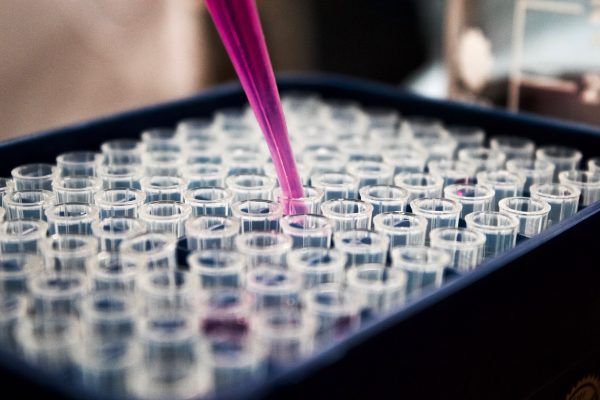When you think of high performance skincare ingredients, actives like Vitamin C or Retinol are probably always top-of-mind. They’ve stood the test of time and they deliver nearly every single time. And if you ask your dermatologist what your skincare arsenal should look like, he or she will probably start the conversation by talking about the importance of sunscreen and antioxidants. In the world of cosmeceutical skincare, there is one particular active ingredient that hasn’t quite taken center stage, but is definitely worthy of our applause: growth factors.
Growth factors entered the realm of skincare by way of traditional medicine and have garnered a small, but formidable cult-like following over the years. There is a good chance you might have heard of growth factors in the context of the “vampire facial” made famous by Kim Kardashian West or Dr. Barbara Sturm’s blood-infused skincare, replete with a patient’s own plasma.
So what are growth factors and how do they perform in my skin care?
Growth factors are large molecules (polypeptides or a molecular chain of amino acids) secreted by all types of cells in the body. They mediate signaling pathways between and within cells and act on cell surface receptors that communicate crucial messages relevant to growth, healing, and survival.[1] Growth factors play a pivotal role in skin rejuvenation and stimulating the formation of dermal collagen. The history behind growth factors validate the ostensible push for this technology in cosmeceutical skincare. One of the first scientists to discover the healing power of growth factors, was biochemist Stanley Cohen in 1952, and he was also one of the scientists awarded the Nobel Prize for this breakthrough in 1986.
Traditionally, growth factors have been harvested to speed wound recovery, therefore applied on open wounds. Wounds do not equal wrinkles, so people often question the efficacy of topical growth factors. When you’re applying these large molecules on in-tact skin, do they penetrate through the stratum corneum (the superficial layer of our skin) and how do they perform? There is a general consensus by experts, highlighted by Rahul Mehta, the vice president for research and development at SkinMedica. It appears that the general hypothesis is: “When growth factors are applied to the skin in high concentrations, a very small fraction of them interact with the topmost layers of the skin, and initiates a communication chain that leads to stimulation of dermal fibroblasts,” sparking collagen production. So, even if there is minimal penetration, the natural communication channels between the dermis and epidermis amplify the effect of topical growth factors. [2]
Where do growth factors come from?
Due to significant advances in biotechnology over the past decade, there are multiple different sources for growth factors. Some are harvested from human components like skin cells or dermal fibroblasts, fat stem cells, and bone marrow stem cells, while others are bioengineered from plants, snails, or bacteria. Some are even entirely synthetic and engineered in a lab. Growth factors can also be derived from one’s own blood through a process called Platelet Rich Plasma (PRP).[3] To support the skin in the most effective way, ideal growth factors are produced by skin cells called fibroblasts.[4] You’re going to want to incorporate something that’s the closest fit to your natural skin physiology.
So, what’s the verdict on growth factor skin care?
We’d say the key takeaway is this: If you’re someone who is looking to accelerate post-procedure healing or simply looking to optimize your skincare regimen, then a growth factor serum is something you should definitely consider. Here at SMD, Dr. Smith believes that “if we’re providing our skin with high quality building blocks, like growth factors, we can potentially get our best, healthiest skin.”
Growth factor products to consider
TNS Recovery Complex® by SkinMedica contains a stabilized blend of 93.6% dermal growth factors originally derived from a single source of neonatal foreskin, and was the first commercially available product containing human growth factors (in the 90s). The blend was originally harvested from fibroblasts (building blocks of collaged) obtained from the neonatal foreskin. To put your mind at ease — there are no actual pieces of foreskin or fetus in the serum — just the naturally secreted proteins from the growth medium of cultured fibroblasts.
Within the SMD range, Cell Rejuvenating Boost is your go-to. The formula contains a robust combination of peptides – one of which binds to the receptor site of a prominent growth factor that performs many cellular functions including cell growth and cell proliferation. Apple and citrus stem cells, as well as Centella Asiatica (known as Gotu Kola or Pennywart), provide rich micro-nutrients to support collagen synthesis. Centella Asiatica is renowned for its anti-aging and wound healing properties.
Written by Maya
Reviewed by Drs. Smith & Fardin
[1] Stone, William L; Varacallo, Matthew, “Physiology, Growth Factor.” NCBI, Nov. 2018. https://www.ncbi.nlm.nih.gov/books/NBK442024/. Accessed 22 Jan. 2020. [2] “Role of Physiological Balanced Growth Factors in Skin Rejuvenation.” Journal of Drugs in Dermatology, vol. 8, no. 5, May 2009, p.7. [3] Ranaweera, Anoma. “Role of Growth Factors in Skin Creams.” Dermnet NZ, Updated January 2019. https://dermnetnz.org/topics/role-of-growth-factors-in-skin-creams/. Accessed 28 Jan. 2020. [4] Mehta, Rahul. “Growth Factors: The Science Behind Skin Rejuvenation.” SkinMedica, June 2016. https://www.skinmedica.com/Blog/GrowthFactors. Accessed 28 Jan. 2020

